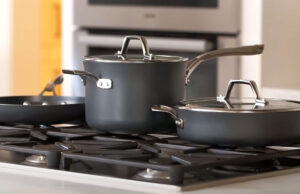As an Amazon Associate, I earn from qualifying purchases at no extra cost to you.
How to Level a Dishwasher Easily Like a Pro at Home
Last month, I helped my neighbor fix her noisy dishwasher that kept rocking every time it ran. It was rattling so much you’d think it was about to take off! The problem wasn’t mechanical at all—it was simply not level. Funny how such a small thing can make such a big mess. In this article, we’ll go step-by-step on how to level a dishwasher the right way.
Adjusting a dishwasher’s level takes six clear actions: check the floor surface, inspect and prepare the base, locate the leveling legs, use a wrench or screwdriver to adjust the legs, confirm balance with a spirit level, and secure it back into position. Each step ensures your dishwasher stays stable, runs quietly, and drains properly. Simple tools, patience, and small adjustments make all the difference in keeping your kitchen peaceful and efficient.
Check the Floor Surface Before Anything Else
Before touching any tools, it’s smart to look closely at the floor under your dishwasher. Sometimes, the issue isn’t the machine itself but the surface it’s sitting on. Uneven tiles or a soft wooden board can throw off the balance completely. Imagine trying to park a car on a slope—it just doesn’t sit right. The same rule applies here.
Run your hand across the area or place a small level tool on the floor. If the bubble isn’t centered, that tells you the base isn’t flat. A small bump or dip can cause vibrations during wash cycles. If you’re on an old kitchen floor, chances are the tiles or boards might have shifted over time. Taking a few minutes to check this saves a lot of effort later.
If you notice an uneven surface, fix it before placing the dishwasher back. You can use small shims or pads to create an even spot. I once used a folded piece of vinyl under a corner—it worked perfectly. Just remember, stability is more important than looks right now. A steady base means fewer rattles and leaks later on.
Lastly, make sure the flooring beneath is dry and clean. Any moisture or dust can make adjustments harder. A quick wipe with a towel or mop can help. Once the surface feels solid and clean, you’re ready to move on.
- Always test the floor with a small level tool
- Fix dips or bumps using shims or pads
- Keep the area clean and dry before adjusting anything
Prepare the Dishwasher Base for Adjustment
Before you start twisting anything, it’s crucial to prepare the dishwasher base properly. Pull the dishwasher out just enough so you can reach underneath comfortably. Be gentle, especially with the water and drain lines—they can kink easily. I usually place a towel underneath just in case a few drops escape from the connections.
Now, check if the insulation blanket or base is in place. Sometimes these shift when the dishwasher is moved, which can throw off leveling. Straighten them out if needed. This small step ensures nothing blocks your access to the adjustable legs or the frame. You’ll also have more room to work with your tools later.
Also, unplug the dishwasher or switch off the power from the breaker. Even though leveling doesn’t involve electrical parts, it’s always better to be safe. Safety first, right? And if the dishwasher connects to a hardwired system, it’s good to double-check there’s no tension in the wires when you move it.
Finally, once the dishwasher is pulled out, take a quick look at all corners. Dust and small objects like bottle caps sometimes get trapped underneath. Clear them out so nothing interferes when you start adjusting. It’s like checking under the hood before tightening a car’s bolts—you just make sure everything’s clear and ready.
- Gently pull dishwasher forward to access the legs
- Straighten insulation or loose panels underneath
- Always turn off power before adjusting anything
Locate and Identify the Leveling Legs
Every dishwasher has adjustable legs, usually two in front and sometimes two at the back. Finding them is the first real “hands-on” step. If you kneel down and look under the front panel, you’ll likely spot small metal or plastic screws near the corners. They might look simple, but these little parts do all the balancing work.
Front legs are usually easy to reach, while rear ones can be trickier. Some models let you adjust the back legs from the front using a long screwdriver. Check your manual or look for access holes just under the door. If your dishwasher doesn’t have that feature, you may need to pull it slightly further out.
I remember helping my cousin with hers, and we spent ten minutes trying to find those tiny screws! They were covered by a bit of grime and dried detergent. A quick wipe made them visible again. So, if you can’t see them right away, don’t panic—sometimes a flashlight helps a lot.
Once you’ve located the legs, note which direction raises or lowers them. Usually, turning clockwise lifts the dishwasher, while counterclockwise lowers it. However, it can vary depending on the model. Knowing this will save you from turning the wrench the wrong way later.
- Look under the front panel for adjustable legs
- Use a flashlight to see clearly
- Check which direction raises or lowers each leg
Adjust the Legs to Level the Dishwasher
Now comes the main part—adjusting the legs. Use a wrench or pliers to turn each one slowly. It’s best to start with the front legs since they’re easiest to reach. Turn one at a time and check how the dishwasher shifts. You don’t want to raise it too much at once. Small movements make big differences here.
Keep an eye on the spirit level as you work. Place it across the top of the door and then from side to side. If the bubble drifts to one side, adjust accordingly. You’ll feel when the machine sits steady—just like adjusting a car’s suspension for balance. A slight wobble means you’re not there yet.
Sometimes, you may find one leg harder to turn than the others. That can happen if it’s been in the same spot for years. A bit of lubricant can loosen it. Just be patient and keep the adjustments gentle. Forcing it might damage the threads.
Once you’ve made the front even, move to the back legs if possible. Repeat the same careful process until everything feels balanced. You’ll notice how much smoother the dishwasher sits now—it shouldn’t rock at all when you press on it.
- Use small, slow turns on each leg
- Check balance using a spirit level
- Avoid forcing tight or rusty screws
Confirm the Level and Secure in Place
After all adjustments, double-check that everything is perfectly balanced. Place your level both horizontally and diagonally on top of the dishwasher. This ensures it’s not only even from side to side but also front to back. The bubble should sit right in the center each time.
If it still leans a little, fine-tune the legs again. Even a quarter-turn can make a big difference. I like to press down gently on each corner to see if it rocks. If there’s no movement at all, you’ve done it right. Sometimes, unevenness comes from one leg not sitting firmly on the floor.
Once the dishwasher feels steady, push it slowly back into its cabinet space. Make sure the water lines, drain hose, and power cord aren’t pinched or bent. Take your time here—rushing could undo all your leveling work. You’ll want everything sitting snug but not overly tight.
Finally, secure the dishwasher to the countertop or side brackets using the screws it came with. This keeps it locked in place so it won’t shift during cycles. A quick test run afterward helps confirm everything’s perfect—quiet, smooth, and stable.
- Recheck balance from all directions
- Push dishwasher back gently and evenly
- Secure with mounting screws for stability
Test the Dishwasher and Make Final Tweaks
With everything secured, it’s time for the final check. Run a short wash cycle while standing nearby. Listen carefully—does it sound smoother? No rattling or shaking should occur. You’ll also notice water draining properly when it’s level, avoiding those annoying leftover puddles inside.
Sometimes, after the first run, you might still hear a faint vibration. That’s fine—it just means one leg might need a tiny adjustment. Open the door, grab your wrench, and turn that leg a little. Even small tweaks can completely fix the issue.
Watch how the door opens and closes too. If it swings open on its own or shuts too quickly, the level might still be slightly off. Adjust until the door stays still when halfway open—that’s a good sign of balance.
Once everything looks and feels perfect, clean up the tools and wipe down the area. A well-leveled dishwasher not only sounds better but also lasts longer since it reduces internal strain. It’s a simple fix that saves money and peace of mind.
- Run a short cycle to test for noise or movement
- Adjust slightly if vibrations continue
- Ensure the door stays balanced when opened
Final Thoughts
Leveling a dishwasher isn’t complicated—it just takes a bit of patience and a few careful adjustments. Once you’ve got it balanced, you’ll immediately notice how quiet and efficient it becomes. It’s one of those simple home fixes that makes a big difference in everyday comfort and appliance lifespan.
| Task | Tools Needed | Quick Tip |
|---|---|---|
| Check floor surface | Spirit level | Fix uneven flooring first |
| Prepare base | Towel, flashlight | Pull dishwasher out gently |
| Locate legs | Flashlight, manual | Look near front corners |
| Adjust legs | Wrench or pliers | Turn slowly, check balance |
| Confirm level | Spirit level | Check in multiple directions |
| Secure dishwasher | Screwdriver | Tighten mounting brackets |
| Test cycle | Water connection | Listen for noise or wobble |
| Final cleanup | Cloth, spray | Wipe surfaces and check hoses |
Frequently Asked Questions (FAQs)
Is it normal for a dishwasher to move slightly when running?
A little vibration can be normal, but noticeable movement or rocking means it’s not level. Dishwashers spin water forcefully, and if one side sits lower, the weight shifts unevenly. That’s when you hear rattles or feel it shake. Once it’s properly leveled, the movement almost disappears. A stable dishwasher runs quieter, drains better, and even protects nearby cabinets from water splashes or leaks.
Can I level a dishwasher without pulling it out completely?
Yes, in many cases you can. Some dishwashers have rear-leg adjustments accessible from the front. Just remove the bottom kickplate and look for small holes or screws. Insert a long screwdriver to turn the back legs while watching the bubble level on top. However, if the back is way off, it’s better to slide the unit out slightly for easier access.
Do I need a professional to level my dishwasher?
Usually, no. Most homeowners can handle it easily with a wrench and a spirit level. Professionals might be needed only if your floor is severely uneven or the dishwasher’s legs are damaged. Taking your time and checking balance from different angles helps you achieve professional results without the cost.
Is it okay if one corner of my dishwasher doesn’t touch the floor?
Not really. Every leg should make full contact with the floor for proper support. If one corner floats, vibrations increase and can loosen connections over time. You can fix this quickly by lowering that leg slightly until it rests firmly. It’s just like making sure all four car tires touch the ground evenly for stability.
Can uneven flooring cause dishwasher leaks?
Yes, definitely. If your dishwasher tilts forward or sideways, water may pool or overflow where it shouldn’t. It can also prevent proper drainage, leaving residue inside after each cycle. Leveling ensures water flows toward the drain, reducing the chance of leaks and odor buildup. It’s a small effort with big payoff.
Do I need to recheck the level after a few months?
It’s a good idea. Over time, floors can shift slightly or legs can loosen from vibrations. Checking every few months keeps your dishwasher in top shape. It only takes a minute to place the level on top and make sure it’s still centered. Think of it like checking tire pressure—quick but important.
Can I use a phone app instead of a physical level tool?
Yes, many phone apps now simulate spirit levels using built-in sensors. They work well for quick checks, especially if you don’t own a real one. Just place your phone flat on the dishwasher door and see where the bubble lines up. However, a traditional spirit level is still more accurate for final adjustments.
Do I have to empty the dishwasher before leveling it?
Absolutely. Always empty it before starting. Dishes and water add uneven weight that can throw off your adjustments. Plus, you’ll need to tilt or move the dishwasher slightly, so it’s safer when it’s empty. Think of it like balancing a car—you wouldn’t load it up before aligning the wheels.




